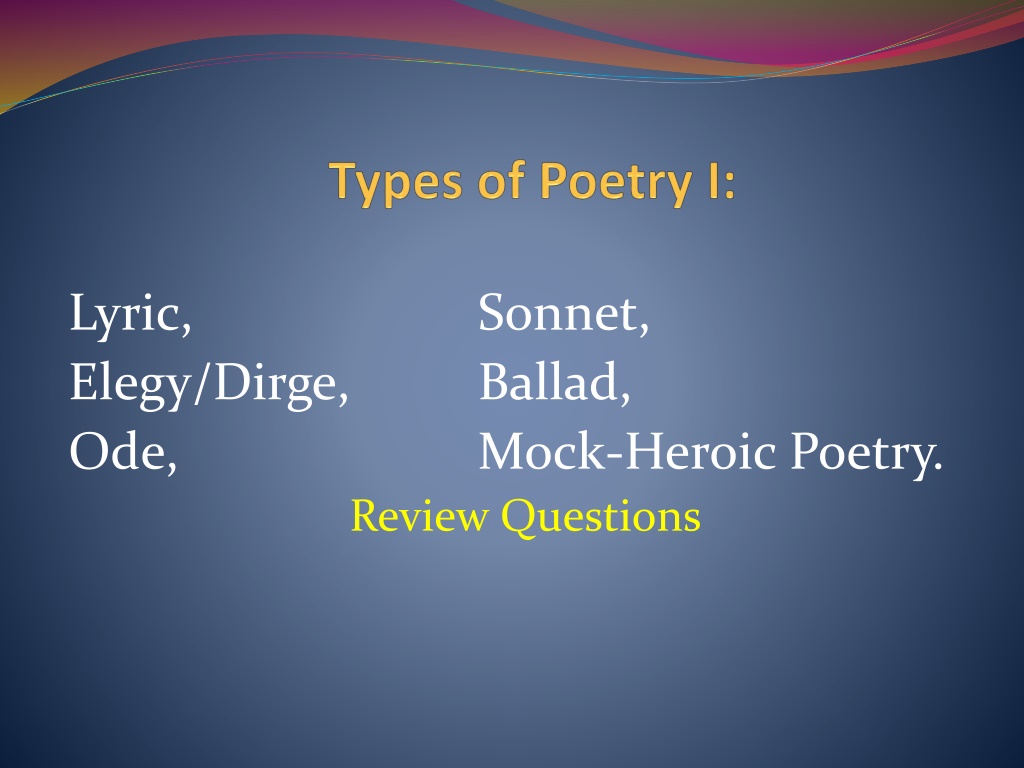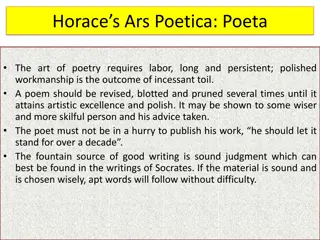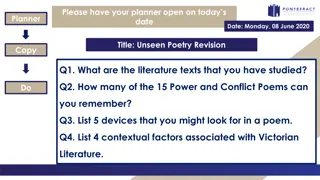Understanding Different Forms of Poetry
Explore the characteristics of different types of poetry such as lyric, elegy/dirge, ode, sonnet, ballad, and mock-heroic poetry. Delve into the personal feelings expressed in lyric poems and the structured beauty of sonnets. Discover the emotive power of elegies and the celebratory nature of odes. This review provides insights into various poetic forms and famous examples from renowned poets like William Wordsworth and John Donne.
Download Presentation

Please find below an Image/Link to download the presentation.
The content on the website is provided AS IS for your information and personal use only. It may not be sold, licensed, or shared on other websites without obtaining consent from the author. Download presentation by click this link. If you encounter any issues during the download, it is possible that the publisher has removed the file from their server.
E N D
Presentation Transcript
Lyric, Elegy/Dirge, Ode, Sonnet, Ballad, Mock-Heroic Poetry. Review Questions
Lyric The lyric is a poem which expresses the personal feeling of the poet or persona in this poem. The word 'Lyric' is derived from the Greek word 'Lyre,' that which connotes a verse appropriate for singing. The lyric poem has the following characteristics: -It is generally brief." -It expresses the poet's deep feelings towards any subject. -Sometimes it is characterised by the employment of the first person pronoun -The subject matter of a lyric poem is centred around love, beauty, death, nature, etc. -As a result of its musical qualities, the lyric poem has evocative rhythms. -It is generally subjective rather than objective in nature. -The lyric is a genre which embodies the following:-sonnet, ode, satire, hymn, and special purpose poetry like that used for drinking, politics, farming, lullabies etc. Examples are Wordsworth's 'I wandered lonely as a cloud,' The Solitary Reaper,' Chinweizu's 'The Epidemic,' elegy, ballad,
The Daffodils by William Wordsworth The waves beside them danced but they Outdid the sparkling waves in glee :- A poet could not but be gay In such a jocund company! I gazed -and gazed- but little thought What wealth the show to me had brought. I wandered lonely as a cloud That floats on high over vales and hills When all at once I saw a crowd A host of golden daffodils Besides the lake, beneath the trees Fluttering and dancing in the breeze... Continuous as the stars that shine And twinkle on the Milky Way They stretched in never ending line Along the margin of a bay Ten thousand saw I at a glance, Tossing their heads in sprightly dance For oft, when on my couch I lie In vacant or in pensive mood They flash upon that inward eye Which is the bliss of solitude; And then my heart with pleasure fills And dances with the daffodils.
Sonnet The sonnet refers to a poem that has fourteen lines. This verse form was introduced in Italy during the 13th century and was experimented upon by many poets including Giacomo Dina, Eltino, Durant and Duitoned'Arezza. Three types of sonnet are discernible in poetry Italian or Petrarchan Sonnet, Elizabethan or Shakespearean sonnet and Spenserian sonnet. Italian or Petrarchan Sonnet The accepted idea is that some of the Italians who used the sonnet form for writing employed two quatrains, and then added a double refrain of six lines, thus forming a sonnet. Dante, however, was the first great poet to use a sonnet (as in 'Vita nauva' and 'Canzoniere'). Dante preferred to use abba, abba, in the first eight lines or octave as a rhyming pattern. The last six lines (or sextet) could rhyme cdc cdc; or cdd dcd; or cd cd cd; or cde cde. The Italian poet Francisco Petrarch later made this type of sonnet popular. Sir Thomas Wyatt: 1503-1542 introduced the sonnet to England. It was in Italy in 1527 that he became fascinated with the love poems of Frascisco Petrarch who had made use of the sonnet. Petrarch's models and the ones that Keats later used had the same rhyming stated above. In the first eight lines (octave) the poet normally stated an experience, a problem or a situation to which the sextet contains the poet s reaction or response. eg
Example of Petrarchan Sonnet Death Be not Proud by John Donne DEATH be not proud, though some have called thee Mighty and draedful, for, thou art not soe, For, those, whom thou thinke'st thou dost overthrow, Die not, poore death, nor yet canst thou kill me. From rest and sleepe, which but thy pictures be, Much pleasure, then from thee, much more must flow, And soonest our best men with thee doe goe Rest of their bones, and soules deliver Thou art slave to Fate, Chance, Kings, and desperate men, And dost with poyson, warre, and sicknesse dwell, And poppie, or charmes can make us sleepe as well, And better than thy stroake; why swell'st thou then? One short sleepe past, we wake eternally, And death shall be no more; death, thou shalt die. (John Donne) - a - b - b - a -a - b -b -a -c - d - d - c - e - f
English or Elizabethan Sonnet English, Elizabethan or Shakespearean Sonnet In the last three sonnets before his death Sir Thomas Wyatt modified the sonnet into three quatrains. Four lines rhyming abab, cdcd, efef, gg. A sonnet in this form presented a problem in the first quatrain, elaborated on it in the second and reached its peak of development in the third quatrain, with the couplet serving as the conclusion. This sonnet, which was later modified, was later known as Elizabethan or Shakespearean sonnet. It was the one mostly used by William Shakespeare and Sir Phillip Sydney in their powerful sonnet poems. Some critics however argue that it was Henry A. Earl of Surrey (1517-27) who actually made use of the Italian sonnet and modified it to Shakespearean sonnet. For example: WHEN IN DISGRACE (sonnet 29) WHEN in disgrace with Fortune and men's eyes, - a I all alone beweepe my out-cast state - b And trouble deafe heaven with my bootless cries, - a And looke upon my selfe and curse my fate. - b Wishing me like to one more rich in hope, - c Featured like him, like him with friends possest, - d Desiring this mans art, and that mans skope, - c With what I most enjoy contended least, - d Yet in these thoughts my selfe almost despising, - e Haplye I thinke on thee, and then my sttaer, - b . (Like to the Larke at breakeof dayearising) - e ,r rom sullen earth sings himns at Heavens gate, - b For thy sweet love remembered such wealth brings - f That then I skone to change my state with kings - f (William Shakespeare)
Spenserian Sonnet This type of sonnet though not quite as popular as those discussed above has its own distinctive features. The rhyming pattern is usually -abab, bcbc, cdcd ee. The statement of problem and its resolution is very much similar to that of English or Elizabethan sonnet.
Elegy/Dirge These are the poems generally written for the dead or to mark very sad occasions. Some critics have argued that whereas the elegy pertains to praising the dead, the dirge focuses more on sorrowful rendition. Example: Mourning Song for Rangiaho by Te Heuheu Herea. Many women call on me to sleep with them But I'll have none so worthless and so wanton There is not one like Rangiaho, so soft to feel Like a small, black eel I would hold her again Even the wood in which she lies; But like the slender flax stem She slides from the first to the second heaven The mother of my children Gone Blown by the wind Like a spume of a wave Into the eye of the void! (From GMT Emezue, African Dirge Poetry)
Ballad Ballads are generally sung. Some deal with ghost stories, animals or birds. Others deal with love issues while yet some concentrate on the escapades of outlaws like Robinson Crusoe or Lord Randall.' General features of a ballad include: Simplicity of diction Precision and different styles. The details, which it deals with, are usually superficial and it jumps from one style to another. It also employs gruesome and grotesque imagery. Examples include John Keat's 'La Belle Dame sans Merci', Samuel Coleridge's 'The Rime of an Ancient Mariner,' Tennyson's 'The Lady of Shallot; P. B. Shelley's The Mask of Anarchy' etc. The two main forms of ballad are the 'folk ballad' and 'literary ballad.' Folk Ballad: This refers to poem songs that usually emerge anonymously in the rural community through centuries. They usually do not have a known composer. An example is the famous 'Lord Randall . Literary Ballad: This refers to more polished ballads written by skilled or trained poets. Ballads can be written in various forms. But the popular ballad has four lines and rhymes abcb. Many ballads of the 'folk' and 'literary' forms depart markedly from the basic stanza form. Let us look at la Belle Dame Sans Merci.'
Ode This is the earliest form of the ode. It is so named because of its wide use by the fifth century Be poet called Pindar. It is the form that found its way into England during the Elizabethan period. The various movements (rather than stanzasJW which it is composed have led to the suggestion that it is related to the pattern of classical drama, in which a chorus chanted lines as it moved or made its turn across the stage, following with a counter turn which brought it back to its original position where a final section of the chant was recited while standing. From this, the name of the Pindaric ode or regular Pindaric ode is derived. An example is the closing part of Thomas Gray's 'The Progress poesy.' The writer may use for the 'turn,' any number of lines usually iambic of any length or variety of lengths and with any rhyme pattern that he wishes. For the 'counter- turn,' he must then follow the 'turn' exactly with respect to these details, while the final section there is usually some variety. Irregular Pindaric Ode This was introduced to England from France by Abraham Cowley. It is sometimes called the Cowelian Ode. This kind of Ode has no 'turn, 'counter-turn' or final section, because the poet is free to vary the number of lines in any of the movements. The lines may be more or less depending on the emotional state of the poet. Examples, Wordsworth's 'Ode on Intimations of Immortality,' Dryden's 'A song for St Cecilia's day.' Horatian Ode or Stanzaic Ode This ode differs from the above two in that as the name implies, a regular stanza structure is used throughout the poem. Examples are William Collin's 'Ode written in the beginning of the Year 1746,' Shelley's 'Ode to the West wind' and Keat's 'Ode to the Nightingale.' In general, the mood of this type of ode is serious and dignified as we can deduce from these first and last stanzas of Keafs To Autumn.' To Autumn These are poems specially composed to mark a special occasion, object or subject. Pindaric Ode
Panegyric Ode Panegyric Odes In this form of poetry, the theme is praise of rulers, notables or other deities, with emphasis on poetic evocation of the hero's exploits rather than a chronological account of successive episodes. This form of poetry is very common in Africa. Example Is the Yoruba Oriki praise poems. Examples are the following; A SOTHO CHIEF'S SON Lightning of the village of Mohato, you who take all and leave nothing If you're not the moon, you're a star; If you're not the sun, you're comet. The child of the chief is like an elephant in spring, He's like a stag that bends low as it runs, When the cannons set the flames ablaze, And the fires take slowly, catch light, and blaze...
Ogun Ogun (Traditional Yoruba poem) Ogun kills on the right and destroys on the right, Ogun kills on the left and destroys on the left. Ogun kills suddenly in the house and suddenly in the field, Ogun kills the child with the iron with which it plays Ogun kills in silence. Ogun kills the thief and the owner of the stolen goods. Ogun kills the owner of the slave and the slave runs away. Ogun kills the owner of thirty 'iwofa' (pawns) and his money, wealth and children disappear Ogun kills the owner of the house and paints the earth with his blood Ogun is the death who pursues a child until it runs into the bush Ogun is the needle that pricks at both ends. Ogun has water but he washes in blood. Ogun do not fight me, I belong only to you. The wife of Ogun is like a tim tim (decorated leather cushion) She does not like two papaw to rest on her. Ogun has many gowns. He gives them all to the beggars. He gives one to the woodcock the woodcock dyes it indigo
Epic & Mock Heroic Poetry This is a long narrative poem with an emphasis on the heroic. The epic is known for its celebration of heroic deeds. The characters in such a poem are mostly gods, divinities, or beings that are supra-human. The issues or themes of an epic poetry are very lofty. Most often, it tries to expound ideas on the existence of good and evil, or the fall of man, as we see in Milton's Paradise Lost. The poem is often written in what is termed 'heroic couplets,' where each two lines of the poem have the same rhyme scheme Where human beings are the focus of an epic poem, as we find in Sundiata for instance they softer cast in the mode of mythic heroes This genre has a wide distribution. Identifiable are two forms the 'oral' and the 'literary epics Example 'oral' epic include those from the ancient world like Sumerian epic of Gilgamesh, the Greek Homeric poems of Illiad and Odyssey and the Indian Mahabharata., or the European epic like the, Sir Garwain and the Green Knight, Beowulf, Song of Roang. In Africa, the epic is a combination of the verse and the prosaic. Examples are the Congolese Mwindo, and Lianja, Sundiata, Oziddi, Chaka Zulu etc. Amongst the 'literary' epic form which were composed by known poets, we have sue examples as John Milton's Paradise Lost and Paradise Regained, John Keat s 'Hyperion' etc. Mock-Heroic Poetry: This is a form of poetry made popular by the Neo-classical poets. It is the use of the epic form of poetry to treat non-serious or mundane issues. A good example is Alexander Pope's The Rape of the Lock where he adopted the form of the heroic couplet and created heroic characters out of natural elementals like the sylphs, salamanders, Ariel etc. The 'battle' is centred on the removal (raping) of a woman's lock of hair by a man in love with her.
Review Questions Classify all the recommended poems according to types. Give cogent reasons for these classification.
Poetry is fun Thank You























